Islamic New Year
 |
| Part of a series on |
| Islamic culture |
|---|
| Architecture |
| Art |
| Dress |
| Holidays |
| Literature |
| Music |
| Theatre |
|
The Islamic New Year, also known as Arabic New Year or Hijri New Year (Arabic: رأس السنة الهجرية Raʼs al-Sanah al-Hijrīyah) is the day that marks the beginning of a new Islamic calendar year, and is the day on which the year count is incremented. The first day of the year is observed on the first day of Muharram, the first month in the Islamic calendar. The first Islamic year begins in 622 AD with the emigration of Prophet Muhammad from Mecca to Medina, known as the Hijra. All religious duties, such as prayer, fasting in the month of Ramadan, and pilgrimage, and the dates of significant events, such as celebration of holy nights and festivals, are calculated according to the lunar calendar.
While some Islamic organizations prefer determining the new month (and hence the new year) by local sightings of the moon,[1] most Islamic institutions and countries, including Saudi Arabia,[2] follow astronomical calculations to determine future dates of the Islamic calendar. There are various schema for calculating the tabular Islamic calendar (i.e. not based on observation), which results in differences of typically one or even two days between countries using such schema and those that use lunar sightings. For example, The Umm al-Qura Calendar used in Saudi Arabia was reformed several times in recent years. The current scheme has been introduced in 1423 AH (15 March 2002).[3]
A day in the Islamic calendar is defined as beginning at sunset. For example, 1 Muharram 1432 was defined to correspond to 7 or 8 December 2010 in official calendars (depending on the country). For an observation-based calendar, a sighting of the new moon at sunset of 6 December would mean that 1 Muharram lasted from the moment of sunset of 6 December to the moment of sunset of 7 December, while in places where the new moon was not sighted on 6 December, 1 Muharram would last from the moment of sunset of 7 December to the moment of sunset of 8 December. [4]
Gregorian correspondence
Since the Islamic lunar year is eleven to twelve days shorter than the solar Gregorian year, the Islamic New Year does not come on the same day of the Gregorian calendar every year.
The following dates on the Gregorian calendar correspond to the Islamic new year:
| Islamic year | Gregorian date |
|---|---|
| 1430 AH | 29 December 2008 |
| 1431 AH | 18 December 2009 |
| 1432 AH | 7 December 2010 |
| 1433 AH | 26 November 2011 |
| 1434 AH | 15 November 2012 |
| 1435 AH | 4 November 2013 |
| 1436 AH | 25 October 2014 |
| 1437 AH | 14 October 2015 |
| 1438 AH | 3 October 2016 |
| 1439 AH | 22 September 2017 |
References
- ↑ Islamic Crescents' Observation Project
- ↑ Islamic Crescents' Observation Project: Saudi Dating System
- ↑ Robert Harry van Gent, The Umm al-Qura Calendar of Saudi Arabia
- ↑ Islamic Crescents' Observation Project, Visibility of Muharram Crescent 1432 AH; seen on 6 December in Algeria, Iran, Saudi Arabia, South Africa.
External links
- Hijri and Gregorian Calendar, Date Conversion on islamicfinder.org
- Islamic New Year (BBC Religion)